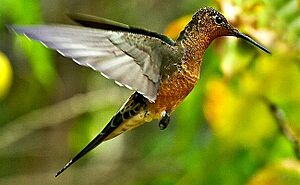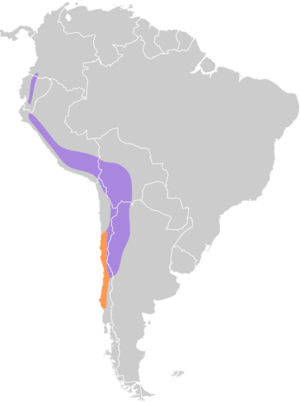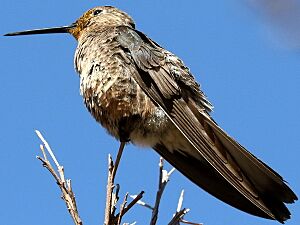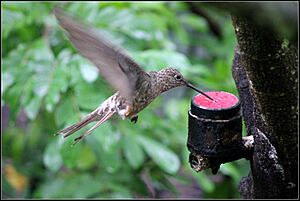Southern giant hummingbird facts for kids
Quick facts for kids Southern giant hummingbird |
|
|---|---|
 |
|
| Patagona gigas in Chile | |
| Conservation status | |
| Scientific classification | |
| Genus: |
Patagona
|
| Species: |
gigas
|
 |
|
The southern giant hummingbird (scientific name: Patagona gigas) is a very large bird. It's one of two types of giant hummingbirds and the second biggest hummingbird species in the world. Its closest relative is the northern giant hummingbird.
Contents
Discovering the Southern Giant Hummingbird
Scientists first described the giant hummingbird in 1824. A French bird expert named Louis Pierre Vieillot wrote about it. He thought the bird came from Brazil, but it was actually from Valparaíso in Chile. Later, in 1840, the giant hummingbird became the only species in a new group called Patagona.
For a long time, scientists thought there was only one type of giant hummingbird. But in 2014, they found out there are actually two different species. These are the northern giant hummingbird (P. chaski) and the southern giant hummingbird (P. gigas).
What Does This Hummingbird Look Like?
Giant hummingbirds are easy to spot because of their huge size. They have a ring around their eyes and a straight beak that is longer than their head. Their feathers are not very bright. They have very long wings that almost reach their tail when they are resting. Their tail is long and a bit forked. They also have feathers on their legs down to their toes, and big, strong feet.
Male and female giant hummingbirds look the same. Young birds have small bumps on the side of their beaks.
Before scientists split them into two species, giant hummingbirds were known to weigh about 18 to 24 grams. Their wingspan was around 21.5 centimeters (8.5 inches). They were about 23 centimeters (9 inches) long. This is about the same length as a European starling. However, hummingbirds are much lighter because they are slender. Their long beaks make their body a smaller part of their total length.
The southern giant hummingbird is more olive green to brown. It does not have white on its chin or throat.
Giant hummingbirds sometimes glide when they fly. This is very rare for hummingbirds. Their long wings help them glide better than other hummingbirds. Their call is a loud, sharp, whistling "chip" sound.
Where Do Southern Giant Hummingbirds Live?
The southern giant hummingbird lives all along the Andes mountains. You can find them on both the east and west sides. They usually live in high-up scrubland and forests during the summer. In winter, they move to similar habitats but at lower altitudes.
These birds can live in many different heights, from sea level up to 4,600 meters (15,000 feet). They can even live near cities and farms. But if too many plants are removed, it limits where they can live.
In summer, they fly south to cooler areas of South America. In winter (March to August), they fly north to warmer, more tropical places.
The southern giant hummingbird lives from northern Bolivia and Chile to Argentina.
How Do Southern Giant Hummingbirds Behave?
Hummingbirds are amazing flyers. They can hover in the air for a long time. They do this to eat, protect their home, and find a mate. The giant hummingbird will bravely defend its territory. They protect their flower patches from other birds, even other giant hummingbirds. These birds are usually seen alone, in pairs, or in small family groups.
Flight and Energy Needs
The giant hummingbird beats its wings about 15 times per second when hovering. This is slow for a hummingbird. When resting, its heart beats 300 times per minute. When flying, it can beat up to 1,020 times per minute!
Flying takes a lot of energy. A giant hummingbird needs about 4.3 calories of food energy every hour to fly. They live in high places where there is less oxygen and thinner air. This makes it harder to fly. Their large size and high energy needs mean they are almost at the biggest possible size for a hummingbird.
What Do Southern Giant Hummingbirds Eat?
The southern giant hummingbird mainly eats nectar from many different flowers. Female hummingbirds sometimes eat sand, soil, or wood ash after laying eggs. This helps them get back the calcium they used for egg production. Nectar does not have much calcium. Also, nectar is low in protein and other minerals. So, they also eat insects to get these important nutrients.
They often feed from Puya flowers in Chile. They help pollinate these plants, and in return, the plants give them food. They also feed from tall cacti like Oreocereus celsianus and Echinopsis atacamensis.
Nectar is a very energy-rich food source. Many other animals try to get it, too. Sometimes, these other visitors damage the flowers. This stops the flowers from making more nectar. Because giant hummingbirds need so much energy, they change how they look for food if other animals are stealing nectar. This can make it harder for hummingbirds to live in areas where many animals steal nectar. If new animals that steal nectar are introduced, it could harm the hummingbird population.
Reproduction
We don't know much about how southern giant hummingbirds raise their young. But we can guess some things from other hummingbird species. Male hummingbirds often mate with many females and do not help after mating. The female builds the nest and lays two eggs during the summer.
A giant hummingbird's nest is small for the size of the bird. They usually build nests near water. The nest is often on a tree branch that is parallel to the ground.
Cultural Importance
The giant hummingbird is important to some native people in the Andes. People on Chiloé Island believe that if a woman catches a hummingbird, she will become very fertile. This bird likely inspired the Nazca culture people. They created the famous Nazca hummingbird geoglyph in Peru.
How Many Southern Giant Hummingbirds Are There?
The southern giant hummingbird lives in a very large area, about 1,200,000 square kilometers (463,000 square miles). There are about 10,000 adult birds. The International Union for Conservation of Nature says this species is of "Least Concern". This means they are not currently at risk of disappearing.
Images for kids






